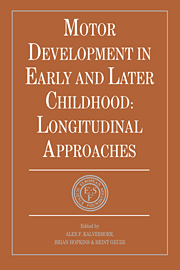Book contents
- Frontmatter
- Contents
- List of contributors
- Foreword
- Preface
- SETTING THE SCENE
- SECTION I BIOLOGICAL BASIS OF MOTOR DEVELOPMENT
- SECTION II DEVELOPMENT OF BODY POSTURE AND GOAL-DIRECTED REACHING
- SECTION III MOTOR DEVELOPMENT, EARLY COMMUNICATION AND COGNITION
- SECTION IV ACQUISITION OF SKILLS
- 12 Individual patterns of tool use by infants
- 13 Tool use, hand cooperation and the development of object manipulation in human and non-human primates
- 14 Handwriting: a developmental perspective
- 15 Development of children's writing performance: some educational implications
- SECTION V MOTOR DEVELOPMENT AND HANDICAP
- SECTION VI METHODOLOGICAL AND CONCEPTUAL CONSIDERATIONS
- Epilogue: description versus explanation
- Index
15 - Development of children's writing performance: some educational implications
from SECTION IV - ACQUISITION OF SKILLS
Published online by Cambridge University Press: 05 May 2010
- Frontmatter
- Contents
- List of contributors
- Foreword
- Preface
- SETTING THE SCENE
- SECTION I BIOLOGICAL BASIS OF MOTOR DEVELOPMENT
- SECTION II DEVELOPMENT OF BODY POSTURE AND GOAL-DIRECTED REACHING
- SECTION III MOTOR DEVELOPMENT, EARLY COMMUNICATION AND COGNITION
- SECTION IV ACQUISITION OF SKILLS
- 12 Individual patterns of tool use by infants
- 13 Tool use, hand cooperation and the development of object manipulation in human and non-human primates
- 14 Handwriting: a developmental perspective
- 15 Development of children's writing performance: some educational implications
- SECTION V MOTOR DEVELOPMENT AND HANDICAP
- SECTION VI METHODOLOGICAL AND CONCEPTUAL CONSIDERATIONS
- Epilogue: description versus explanation
- Index
Summary
INTRODUCTION
The term ‘writing’ refers to the perceptual–motor behaviour called handwriting, the graphic product of this behaviour, and the verbal message presented by the written product. This chapter concentrates on the perceptual–motor process and product variables of writing (handwriting) as these are closely related to the main theme of this book.
Research in the complex, perceptual–motor skill called handwriting has been based on different theories. Consequently, knowledge acquired on the development of handwriting is both diverse and rather difficult to describe in a clear, balanced manner. However, researchers seem to agree on the fact that writing is a flowing task rather than a set of discrete responses, even though there are interruptions at word boundaries for instance. Writing is generally held to be a variety of different, coordinated movements which are subject to visual monitoring, feedback, and guidance. Skilled writing movements are complex and are among the most advanced achievements of the human hand. This activity is precisely coordinated under neural control in accordance with related space and time factors. Thus, writing is subject to strict requirements with regard to the timing and force control of the coordinated movements of arm, wrist, hand, and fingers.
Writing is one of life's most important educational skills. It involves instrumental behaviour patterns which require the use of synthetic devices for their execution. An early stage in learning such skill, is the acquisition of subskills concerned with ‘getting the idea of the orientation required in order to be capable of picking up the appropriate environmental information on which the control of the skill depends’ (Whiting, 1972).
- Type
- Chapter
- Information
- Motor Development in Early and Later ChildhoodLongitudinal Approaches, pp. 229 - 246Publisher: Cambridge University PressPrint publication year: 1993
- 8
- Cited by



